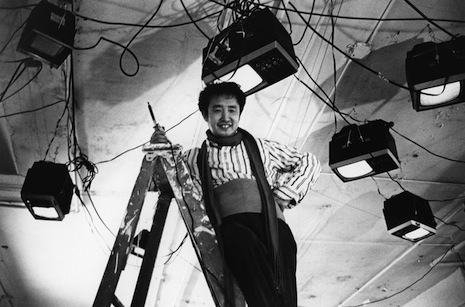
John Cage performs with a feather while George Plimpton narrativizes (inset)
George Orwell’s sinister novel Nineteen Eighty-Four made it inevitable that the arrival of his eponymous year would be a media event. Decades after his death, Orwell made it onto the cover of Time magazine in late 1983, but on the big day itself—January 1, 1984—TV visionary Nam June Paik ushered in the year with an ambitious international video program called Good Morning, Mr. Orwell that was broadcast live simultaneously from New York (WNET public television), Paris, and San Francisco, with broadcasters in Germany and South Korea also carrying the transmissions if not contributing content.
According to Plimpton, Paik aptly referred to the project as a “global disco.” As the title suggested, Paik’s take on 1984 was considerably rosier than that of Orwell. In the spirit of Fluxus and/or technological optimism, as you please, Paik gathered a roster of artists with less inclination to lean on bleak themes such as Peter Gabriel, Laurie Anderson, John Cage, Allen Ginsberg, Merce Cunningham, Salvador Dalí, Oingo Boingo and many others for a stimulating showcase of art, music, theater, and video manipulation. One might imagine a band like DEVO being invited but it’s difficult to imagine Mark Mothersbaugh and Jerry Casale mustering up any enthusiasm for a project in which it was unironically asserted that technology is a boon to mankind.
The show was hosted by George Plimpton—the John Hodgman of his day, kind of—with assistance from the Centre Pompidou in Paris. In a move you can’t imagine happening today, Plimpton enthusiastically names the satellite—Bright Star—assisting with the remote sync-up. We would consider that akin to singling out the dedicated server permitting YouTube to bring you a video.
Among the performances: Gabriel and Anderson combine on a duet called “Excellent Birds”; a fitfully amusing comedy sketch called “Cavalcade of Intellectuals” in which a transatlantic discussion devolves into an interpersonal spat (a gag that worked better in Airplane! using airport PA announcers); a sprightly song by Yves Montand; John Cage plays “amplified cacti and plant materials” with a feather (so great); Oingo Boingo perform a song called “Wake Up (It’s 1984)”; Allen Ginsberg and Peter Orlovsky sing a little ditty about meditation to the cello stylings of Arthur Russell; and much more.
Watch ‘Good Morning, Mr. Orwell’ after the jump…








